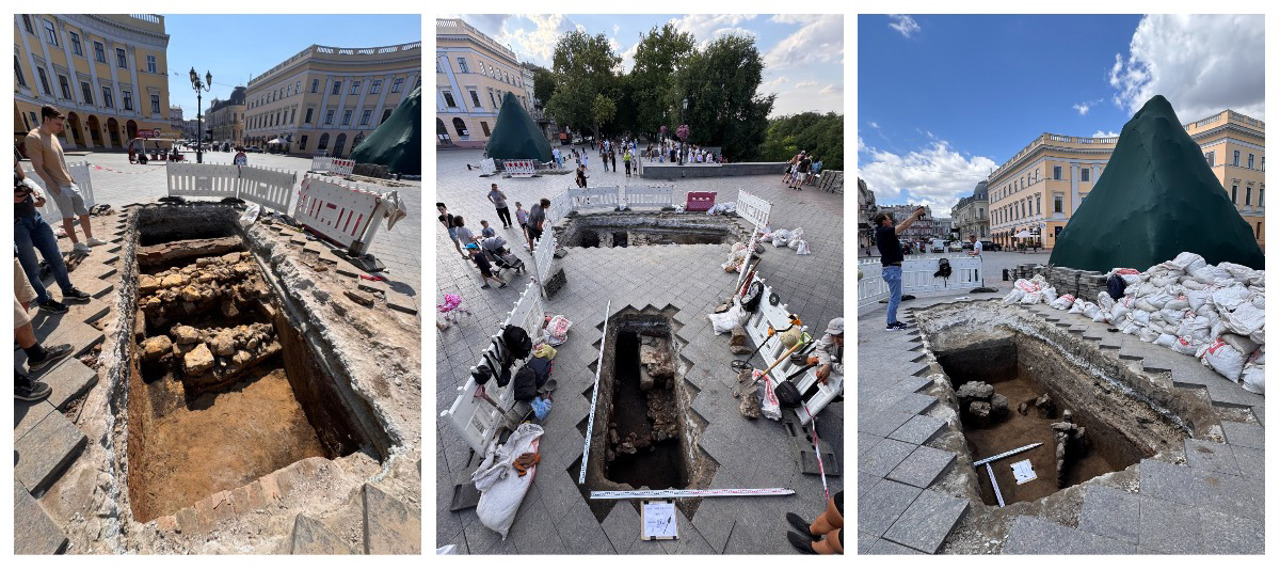Archaeological excavations at the foot of the Duke de Richelieu monument have revealed not only fragments of a defensive structure from the Ottoman period, but also earlier artifacts of Genoese origin.
The remains of the Ottoman fortress of Khadzhibey were found on Prymorskyi Boulevard in Odesa by archaeologists from the Ushynsky South Ukrainian National Pedagogical University, who conducted excavations together with specialists from the Institute of Archaeology of the NAS of Ukraine. The sensational results of the research on the territory of the semicircular square were shared by the rector of the university, historian Andrii Krasnozhon.
"Khadzhibey Castle has been found! The debates about its location, which lasted for almost 200 years, have been put to rest. They were aggravated by the lack of reliable cartographic data and written sources, as well as traces of this defensive structure, which was blown up by Russian troops shortly after the assault of 1789, and later dismantled for building materials," Krasnozhon said on his Facebook page.
According to the results of the study, the castle was located between the semicircular building No. 8, the funicular, the Duke monument and the alleys of the southern part of the boulevard, occupying a square of approximately 40 by 40 meters.
"In two excavations and two pits, we found the front wall of the coastal artillery battery, which was added to the castle from the shore, as well as traces of the dismantling of the curtains. We managed to record the angular intersection of this wall with the side wall, which covered the battery from the southeast," the historian noted.
The base of the castle battery wall is recessed into the antique layer of the 5th century BC. According to the researcher, this is the first time that it has been possible to trace the cultural layers of the ancient Greek settlement of Istrian Harbor within its northern border. In addition, in the excavation under the Duke's monument, a pile of stones and blocks were discovered, pulled from the walls of the destroyed castle, among which were massive capitals of Ottoman-type pylons.
Having located the castle and tied the plans to the area, archaeologists now plan to begin searching for its main, capital buildings. But the time of the foundation of the ancient structure will still have to be clarified.
"Some intrigue in these searches is caused by ceramics and numismatics of the 14th century, the finds of which are now the norm in excavations on Prymorskyi Boulevard. For example, one of the fragments of an imported Byzantine bowl of this period was found in the same stratigraphic context as the mentioned capitals of pylons, albeit in a re-deposited state, however... Archaeological artifacts of the 14th century, as is known, mark a completely different historical period - associated with the Italian factory of Ginestra," says Krasnozhon.
Until recently, archaeologists did not know whether there were any chances at all to find the remains of the castle, since the structure stood on the very edge of a coastal plateau prone to landslides.
Photo: facebook.com/andrew.krasnozhon.2025
Залишки османської фортеці Хаджибей знайшли на Приморському бульварі в Одесі археологи Південноукраїнського національного педагогічного університету імені Ушинського, які проводили розкопки спільно з фахівцями Інституту археології НАН України. Сенсаційними результатами дослідження на території напівциркульної площі поділився ректор університету, історик Андрій Красножон.
"Хаджибейський замок знайдено! Поставлено крапку в дискусіях щодо його локалізації, які тривали майже 200 років. Вони посилювалися відсутністю достовірних даних картографії та письмових джерел, а також слідів цієї оборонної споруди, яку підірвали російські війська невдовзі після штурму 1789 року, а згодом розібрали на будматеріали", – розповів Красножон на власній сторінці у Facebook.
Згідно з результатами дослідження, замок розташовувався між напівкруглим будинком № 8, фунікулером, пам'ятником Дюку та алеями південної частини бульвару, займаючи квадрат приблизно 40 на 40 метрів.
"В двох розкопах та двох шурфах ми знайшли фронтальну стіну артилерійської берегової батареї, що була добудована до замку з берега, а також сліди демонтажу куртин. Вдалося зафіксувати кутовий перетин цієї стіни з бічною, що прикривала батарею з південного сходу", – зазначив історик.
Своєю основою стіна замкової батареї впущена в античний шар V століття до нашої ери. За словами дослідника, це вперше, коли вдалося простежити культурні нашарування давньогрецького поселення Гавань Істріан у межах його північного кордону. Крім того, в розкопі під пам'ятником Дюку виявили купу каміння та блоків, витягнутих зі стін зруйнованого замку, серед яких були й масивні капітелі пілонів османського типу.
Локалізувавши замок та прив'язавши плани до місцевості, археологи тепер планують розпочати пошуки його основних, капітальних будівель. А от час заснування давньої споруди ще доведеться з'ясувати.
"Якусь інтригу в цих пошуках задає кераміка та нумізматика XIV століття, знахідки якої тепер вже є нормою в розкопках на Приморському бульварі. Так, один із фрагментів імпортної візантійської чаші цього періоду знайдено в одному стратиграфічному контексті зі згаданими капітелями пілонів, хоч і в перевідкладеному стані, проте... Археологічні артефакти XIV століття, як відомо, маркують зовсім інший історичний період – пов'язаний з італійською факторією Джинестра", – стверджує Красножон.
Археологам до останнього не було відомо, чи є взагалі шанси знайти залишки замку, оскільки споруда стояла на самому краю берегового плато, що схильне до обвалів.
Фото: facebook.com/andrew.krasnozhon.2025



